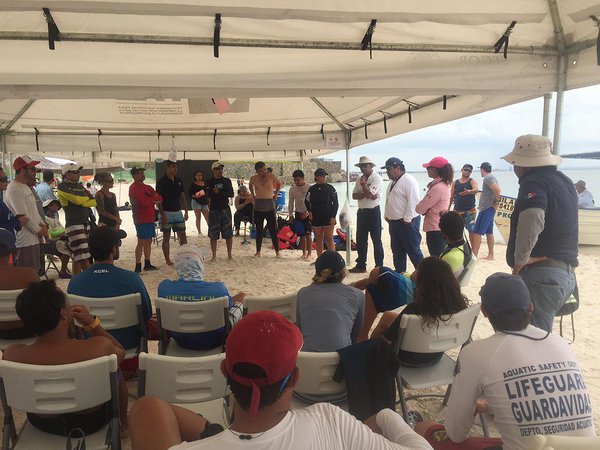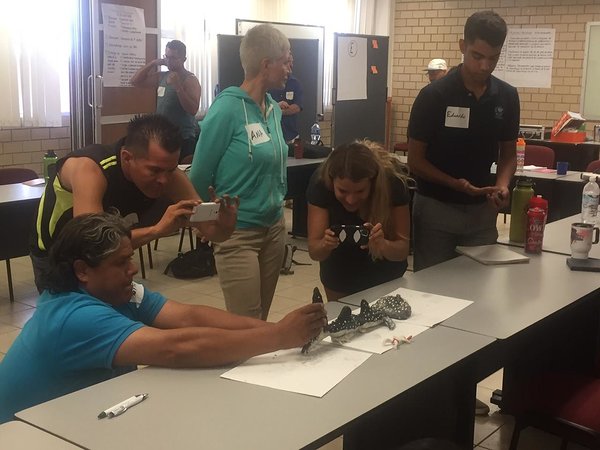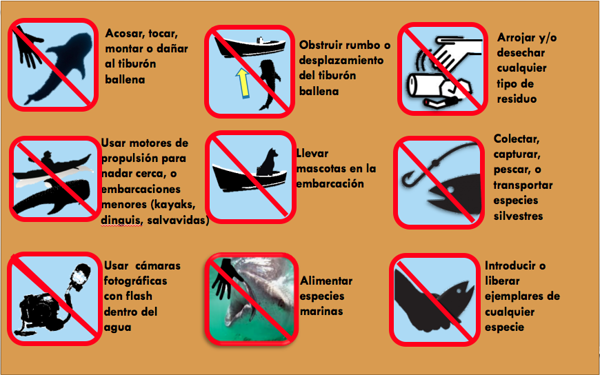Whale Shark Season Approaches in La Paz, BCS
Whale Sharks are an important part of the ecology, culture and economy here in La Paz. They are a magnificent creature that deserves to be respected and appreciated. New regulations here in La Paz are designed to help protect the species and educate our visitors. Last week your crew at El Duque Adventures took part in the first 4 day course designed by SEMARNAT to ensure safe practices when visiting the whale sharks here.
The course consisted of theoretical work, group exercises and practical in water evaluation to ensure that all guides are capable and respectful of the animals. With a collaboration between SEMARNAT, Port Authority, Mexican Navy, Search and Rescue, PROFEPA and CICIMAR and a number of local tour providers it was a well rounded course with the chance to improve how services are offered and also how to cut down on illegal activity which may harm the whale sharks.
The whale sharks that we tend to see here in La Paz are predominantly juvenile males who spend the winter months here feeding on plankton that accumulates in the bay after being bought in from deeper water by our consistent northerly winds. These males have shown a high fidelity rate with many returning year after year and becoming well known to guides and captains in the local area. Unfortunately last season about 2/3 of whale sharks seen in the area had some sort of damage therefore the initiative to create safer working practices was necessary.
So what is a whale shark? A whale shark is the largest fish in the ocean - it is part of the shark family as, like all sharks it is composed of cartilage and not bone, but it is called a 'whale' shark due to its great size. It has other special characteristics that place it in the fish not mammal family.
1) It has gills just behind its head, these are used to take oxygen out of the water and into the animals blood and pass to back the carbon dioxide so that it can be taken away by the water. What do mammals like you and me use to breath? Our lungs – whale sharks have gills not lungs for breathing. This means that they do not need to come to the surface for air.
2) The way that they swim – a fishes tail moves from side to side whereas a mammal moves up and down.
3) Mammals give live birth and their young feed on milk. Whale sharks are an ovoviviparus species, this means that they give birth to live young, but they show a different method of internal nourishment than associated with mammals such as humans. The embryo's initial devlopment occurs within an egg, it gains nutrients from the yolk however the embryo emerges from the egg whilst still inside of the mother. Once it is out of the egg it receives nourishment from special glands inside the other until it is ready to be born. This is also seen in other sharks species such as great whites and basking sharks. When the pups are born they are on their own.As adults they can reach an average size of
12m, sometimes larger. Here in La Paz we
have a very special area for seeing juvenile whale sharks. These ‘juveniles’ are still 3-5m on average –
so perhaps as long as the boat that you go out in!
So these whale sharks eat plankton; this makes them a gentle giant who is not interested in eating you! Whale sharks have a large mouth at the front of their body and they open this up to take in water and the plankton in it. This plankton gets trapped on their gill rakers – special adaptions they have around their gills so that they can get the nutrients. They do have teeth – 1000’s of them! But they are not used in food consumption and only a relic feature from the past. For this reason they are not interested in us humans and we an enjoy their presence in a safe manner.
Little is known about the life of a whale shark as they mostly tend to be solitary creatures who live a migratory lifestyle. They can be found in different locations worldwide in but only a few places are as lucky as us to have they reliably return. Mexico is a great destination for seeing whalesharks young and adult and for this reason we have some rules in place to ensure that you have a great time and that they also continue to feel safe enough to return.
This season if you go out to visit the whale sharks please make sure you follow the new regulations and go with an authorised operator - someone who is displaying a current flag and will also take the time to tell you more about these fantastic fish. These authorised operators have trained guides and captains as well as vessels that have passed safety inspections. They are committed to making this activity both enjoyable and sustainable.
If you would like to come on a whale shark adventure with us then please get in contact via info@elduqueadventures.com or call +1 52 612 176 5570.
Hope to see you on the water....
Some of this years regulations:



